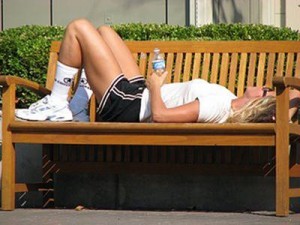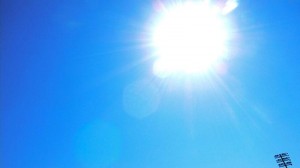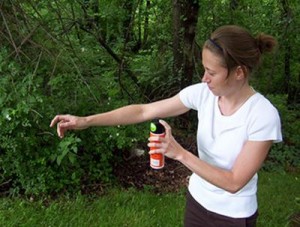Summer is in full swing and so are its soaring temperatures. If you’re planning on spending time outdoors during your summer travels, it’s important to take the following precautions to keep you and your family safe and healthy.
Prevent Heat-Related Illnesses
As temperatures and humidity levels rise, so does the risk of the following heat-related illnesses:
Dehydration
 Dehydration occurs when you lose more body fluid by sweating or urinating than you replace by drinking, and your body doesn’t have enough water and other fluids to carry out its normal functions. Anyone may become dehydrated, but young children, older adults and people with chronic illnesses are most at risk. Symptoms of dehydration include dry or sticky mouth, thirst, no or low urine output, headache and dizziness.
Dehydration occurs when you lose more body fluid by sweating or urinating than you replace by drinking, and your body doesn’t have enough water and other fluids to carry out its normal functions. Anyone may become dehydrated, but young children, older adults and people with chronic illnesses are most at risk. Symptoms of dehydration include dry or sticky mouth, thirst, no or low urine output, headache and dizziness.
What you can do to avoid dehydration:
- Drink plenty of fluids, such as water or sports drinks high in electrolytes.
- Avoid excess amounts of alcohol and caffeine, as both are considered to be diuretics.
- Eat foods high in water content, such as fruits and vegetables.
When to see a doctor:
You should see a doctor if you’re unable to hold down any fluids, feel faint, weak or disoriented.
Heat Exhaustion
Heat exhaustion is caused by the body’s loss of water and salt, often as a result of exercise or prolonged activity in hot weather. If it is not treated, it may progress to heat stroke. Symptoms may include heavy sweating and a rapid pulse, a result of your body overheating. Without prompt treatment, heat exhaustion can progress to heatstroke, a life-threatening condition. Fortunately, heat exhaustion is preventable.
What you can do to avoid heat exhaustion:
- Hydrate often and regularly. If you wait until when you’re feeling thirsty, there is already a significant fluid deficit.
- Plan your outdoor activities in places with shade available. If you’re going to the beach, bring an umbrella to sit under.
- Monitor your urine, which should have a yellowish tint. If it’s a dark color, drink more water.
- Wear loose, lightweight and light-colored clothing, as dark clothing absorbs heat.
When to see a doctor:
If you think you’re experiencing heat exhaustion, move to a cooler place and drink plenty of cold water or a sports drink. Contact your doctor if your signs or symptoms worsen or if they don’t improve within one hour. Seek immediate medical attention if your body temperature reaches 104°F or higher.
Heatstroke
 Heatstroke, the most dangerous heat-related illness, resembles heat exhaustion, but may additionally involve neurological symptoms such as confusion and dizziness, or even a coma. The body can no longer sweat and its internal temperature skyrockets.
Heatstroke, the most dangerous heat-related illness, resembles heat exhaustion, but may additionally involve neurological symptoms such as confusion and dizziness, or even a coma. The body can no longer sweat and its internal temperature skyrockets.
What you can do to avoid heat stroke:
- Try to avoid strenuous physical activity outside during the hottest time of the day — between 10 a.m. and 6 p.m.
- Drink plenty of water every half-hour or so and take breaks from your outdoor activity in a cool environment if possible.
- Get acclimatized. Limit the amount you spend doing strenuous outdoor activity in the heat until you’re conditioned to it. People who are not used to hot weather are especially susceptible to heat-related illness, including heatstroke. It can take several weeks for your body to adjust to hot weather.
When to see a doctor:
Heat stroke is a medical emergency. If someone is suffering heat stroke symptoms and their body temperature goes above 104°F, or if coma or seizure occurs, call 911 or go directly to the emergency room of the nearest hospital.
Protect Against Insects
As we mentioned in our Long Weekend Travel Tips, taking proper precautions against insects such as mosquitoes or ticks can be vital to your health.
West Nile Virus
 West Nile virus is spread by mosquitos, which contract the virus from infected birds. Symptoms of infection include: fatigue, fever, headache, body aches, rash, and swollen lymph nodes. There is no vaccine or specific treatment for West Nile virus.
West Nile virus is spread by mosquitos, which contract the virus from infected birds. Symptoms of infection include: fatigue, fever, headache, body aches, rash, and swollen lymph nodes. There is no vaccine or specific treatment for West Nile virus.
Protect yourself:
- Use insect repellent containing at least 10%DEET.
- Dress in long pants, long sleeves and socks. Mosquitoes may bite through thin clothing, so spraying clothes with repellent containing permethrin or another EPA-registered repellent will give extra protection.
- Take extra care during peak mosquito hours (right around dusk and dawn).Take extra care to use repellent and protective clothing from dusk to dawn or consider avoiding outdoor activities during these times.
When to see a doctor:
Symptoms usually occur three days to two weeks after a bite from an infected mosquito. If you notice any severe symptoms such as high fever, muscle weakness, vision loss or tremors, see your doctor right away.
Lyme Disease
Lyme disease is a bacterial infection transmitted to humans through the bite of infected blacklegged ticks. Symptoms of Lyme disease include fever, headache fatigue, and a characteristic skin rash called erythema migrans. If left untreated, infection can spread to joints, the heart and the nervous system.
Protect Yourself:
- Avoid wooded and bushy areas with high grass and leaf litter (fallen leaves piled on the ground).Walk in the center of trails.
- Use repellents that contain 20% or more DEET on any exposed skin for protection that lasts up to several hours.
- Use products that contain permethrin on clothing. Treat clothing and gear, such as boots, pants, socks and tents.
- Bathe or shower as soon as possible after returning indoors (preferably within two hours) to wash off and find ticks.
When to see a doctor:
If you’ve been bitten by a tick, call a doctor if you experience swelling and joint pain, tingling and numbness in your hands, feet and back and a severe lack of energy. You also may see a round, red rash close to where the bite occurred. It’s also best to see your doctor if you found a tick on your body that you are having trouble removing, as your doctor can help to remove it safely.
Swim Safely
 Swimming is a very popular summer activity, and one many adults love just as much as kids. Here are some tips on how to keep safe and healthy while swimming:
Swimming is a very popular summer activity, and one many adults love just as much as kids. Here are some tips on how to keep safe and healthy while swimming:
- Enroll in age-appropriate swim lessons
- Swim in designated areas supervised by lifeguards.
- Always swim with a buddy; do not allow anyone to swim alone. Even at a public pool or a lifeguarded beach, use the buddy system!
- Have young children or inexperienced swimmers wear life jackets or arm floaties around water, but do not rely on life jackets alone – close supervision is still a must.
- Even if you do not plan on swimming, be cautious around natural bodies of water including ocean shoreline, rivers and lakes. Cold temperatures, currents and underwater hazards can make a fall into these bodies of water dangerous.
- If you begin to be carried out by a current, always swim sideways, parallel to the beach. This will get you out of the narrow outward current, so you can swim back in with the waves helping you along. Call for help, but try to remain as calm as possible and refrain from thrashing about in the water.
Check out American Red Cross’ full article on Water Safety Advice for even more tips on keeping your family safe while at the beach, in the pool or at the lake.
How do you stay safe and healthy while spending time outdoors in the summer months? We’d love your advice in comments below!
Safe Travels!
Photo Credits
Water Stop and Rest by RobertHuffstutter
Repellants by FairfaxCounty
Hot Sun by Bredgur
Family Swim by Jeffrey Tripp


